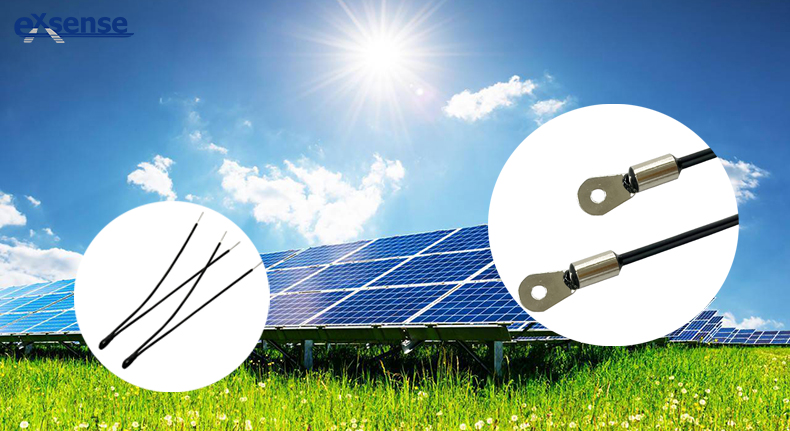Precise Temperature Control in Photovoltaic Solar Energy: NTC Temperature Sensors NTC thermistor sensors
Amid the global energy structure’s accelerated transition toward renewable energy, photovoltaic (PV) solar energy, as a clean and sustainable energy solution, has emerged as a driving force in advancing energy regeneration. However, the efficient and stable operation of PV systems faces numerous challenges, among which the impact of temperature on system performance cannot be overlooked. Leveraging their high sensitivity and rapid response characteristics, Negative Temperature Coefficient (NTC) temperature sensors have become indispensable components in PV solar systems. They are pivotal in ensuring system safety and enhancing power generation efficiency.
Ⅰ.Working Principles of Photovoltaic Solar Energy
A solar PV power generation system relies on the photoelectric effect of semiconductor materials to convert solar radiation into electricity efficiently. The generated electricity follows two utilization pathways:
- Energy Storage: Excess direct current (DC) is converted into chemical energy via a charge controller and stored in batteries for cross-temporal energy use.
2.Direct Power Supply: An inverter converts DC into alternating current (AC) compliant with household standards, enabling direct power supply to appliances.
Throughout the photoelectric conversion, energy storage, and discharge processes, heat is generated during carrier migration in semiconductor materials and the operation of inverter power devices.
Below, we detail how NTC sensors function in 3.PV solar energy storage and temperature control:
A PV system comprises modules such as solar collection, temperature control, and energy storage, including equipment like solar cell arrays, battery packs, charge controllers, inverters, AC distribution cabinets, and solar tracking control systems.
- Collection Module: Harvests solar energy and converts it into electricity for daily power supply. However, since DC generated by solar cells cannot directly power most conventional appliances, inverters are required to convert DC into stable AC.
- Storage Module: Stores excess daytime energy in batteries to power buildings at night.
- Temperature Control Module: This module includes components like thermostats and NTC temperature sensors. The thermostat adjusts configurations to regulate internal building temperatures by monitoring temperature changes in inverters and batteries.
Ⅱ.Practical Applications of NTC Temperature Sensors
NTC temperature sensors are integral to PV solar systems. Key application scenarios include:
1.PV Cell Temperature Monitoring:
The efficiency of PV cells is highly temperature-dependent. As temperatures rise, output power typically declines. NTC sensors provide real-time temperature feedback to control systems, enabling operators to monitor cell status. For example, distributed NTC sensor networks in large-scale PV plants track temperature variations across individual panels or zones, allowing timely cooling or optimization measures to enhance efficiency.
2.Inverter Temperature Monitoring:
Inverters, which convert DC to AC, generate heat during operation. Excessive temperatures reduce conversion efficiency, shorten lifespan, and may cause failures. NTC sensors installed in inverters monitor critical components. When temperatures exceed thresholds, alarms or cooling systems (e.g., fans) are triggered to maintain safe operating conditions and ensure system stability.
Ⅲ.NTC Sensor Selection and Installation Guidelines
Different PV system modules require tailored NTC sensors:
- Inverters: Ground loop metal series sensors are recommended for their superior electromagnetic compatibility and mechanical durability.
- Battery Packs: Epoxy head series (ideal for lightweight, high-insulation scenarios) or ground loop metal series (for high-temperature and vibration resistance) can be selected based on application needs.
Installation Methods:
- Surface Mounting: Sensor pins are soldered to circuit boards and bonded to surfaces with thermal conductive silicone. This ensures rapid heat transfer, minimizes measurement lag and is ideal for real-time temperature monitoring in battery cells and Battery Management Systems (BMS).
- Fixed Plate Installation: Ground loop metal-shell sensors are secured to equipment surfaces via screws or laser welding. This robust mechanical connection suits high-power devices like transformers, inverters, and charging stations, offering vibration resistance and long-term stability in harsh environments.
Conclusion
The PV solar industry faces unprecedented growth opportunities against the backdrop of global energy transformation. As a critical sensing component, NTC thermistor sensors ensure system safety, stability, and efficiency through precise temperature monitoring and intelligent control. With continuous technological innovation and expanding applications, NTC sensors will further propel the advancement of clean energy, contributing to global sustainable development goals.














